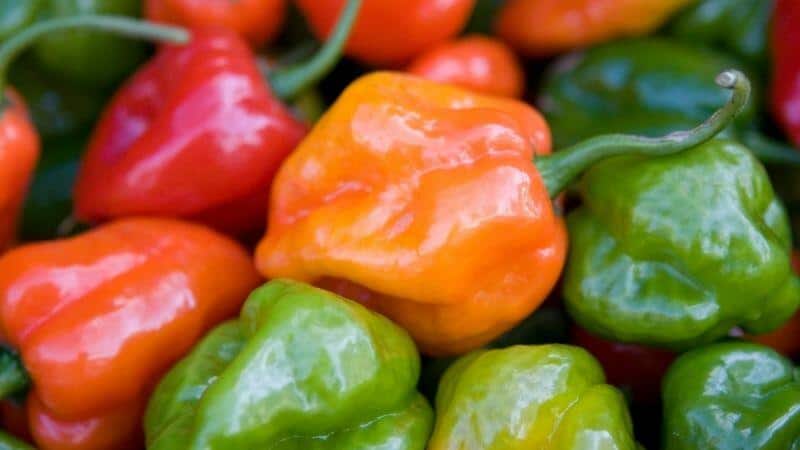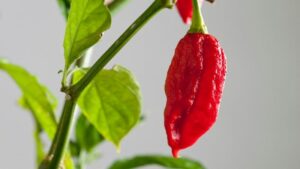If you love spicy heat, you’ve probably wondered about the fiery face-off of ghost pepper vs habanero. Which one of these peppers will really bring the burn?
The short answer is that ghost peppers are much hotter than habanero peppers!
On the Scoville scale, the measurement of spiciness, ghost peppers rate between 855,000 to over 1 million Scoville Heat Units (SHU). That’s up to 300x hotter than the habanero!
Ghost peppers earned their firey reputation in 2007 when they became the first chili ever to hit 1 million SHU. That record-breaking heat makes them the undisputed
Habaneros rate between 100,000 to 350,000 SHU, only about 1/10 as hot as ghost peppers. Back in 1999 habaneros were the world’s hottest peppers, but they’ve since been surpassed by the intense ghost pepper.
While both peppers start out with fruity flavor, the slow-building burn of the ghost pepper sets it apart. Keep reading to learn exactly why ghost peppers pack so much more heat than habaneros.
How Hot is a Ghost Pepper?
Nicknamed “Bhut jolokia,” the ghost pepper blows away the competition on the Scoville scale. Ranging from 855,000 to over 1 million Scoville Heat Units (SHU), it easily trounces the habanero.
When the ghost pepper came onto the scene in 2007, it stunned the world by being the first chili to hit 1 million SHU. This record-breaking
Habanero Heat Levels Don’t Come Close
The habanero pepper packs a punch between 100,000 to 350,000 SHU. That’s only about 1/10 as hot as the ghost pepper!
Back in 1999, the habanero wore the crown for the world’s hottest pepper. But its spicy reign ended when the ghost pepper turned up the heat.
While both peppers start out with fruity notes, the habanero has a more balanced flavor. Meanwhile, the ghost pepper surprises you with an intense slow burn. It’s like getting tricked by a hot pepper in disguise!
Ghost Pepper SHU vs. Other Popular Hot Sauces and Peppers
Check out how the ghost pepper compares on the Scoville scale to other spicy favorites:
- Tabasco sauce – Ghost pepper is 400x hotter
- Jalapeno – Ghost pepper is 200x hotter
- Habanero – Ghost pepper is 6-10x hotter
The ghost pepper blows the competition away! It’s no wonder the ghost pepper remains the benchmark for extreme heat.
Why Ghost Peppers Are Hotter Than Habaneros
So what gives the ghost pepper its scorching-hot advantage over habaneros? The answer comes down to one fiery compound: capsaicin.
The higher concentration of capsaicin is what makes the ghost pepper so much hotter. Habaneros have more of a fruity flavor because they contain less heat-inducing capsaicin.
Other factors also influence the spiciness of these peppers:
- Growing conditions – Proper care makes peppers hotter.
- Watering – Too much water dilutes heat.
- Climate – Hot climates produce hotter peppers.
- Plant genetics – The right pepper seeds pack more punch.
- Ripeness – Fully ripe peppers are hottest.
Cooking Won’t Make Habaneros as Hot as Ghost Peppers
While cooking makes peppers hotter, habaneros still can’t catch up to ghost peppers. Their lower natural capsaicin levels cap how hot they can get.
Deep-frying reduces spiciness since it breaks down capsaicinoids. Meanwhile, boiling and grilling increase heat.
And unripe green peppers are never as hot as ripe red ones since capsaicin increases during ripening.
Ghost Pepper vs Habanero: Key Differences
| Pepper | Scoville Heat Units | Heat Factor | Taste | Size | Appearance |
|---|---|---|---|---|---|
| Ghost Pepper | 855,000 – 1,041,427 | 107-417x hotter than jalapeno | Sweet, fruity, earthy | 2-3 inches long | Wrinkly, pod-like |
| Habanero | 100,000 – 350,000 | 12-140x hotter than jalapeno | Sweet, fruity, tropical, smoky | 1-3 inches long | Smooth, pod-like |
Ready to Feel the Burn?
Now that you know just how much hotter ghost peppers are, you can turn up the heat in your spicy recipes! When you need an inferno of flavor, go with the ghost pepper. Or choose the habanero when you want a slower, smoky burn.
The battle for pepper supremacy ends in a scorching victory for ghost pepper! Will you dare to try one of the world’s hottest?





